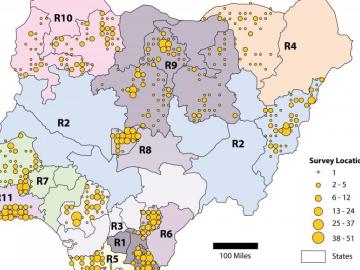
Filter News
Area of Research
- (-) Fusion Energy (17)
- (-) Isotopes (35)
- (-) National Security (80)
- (-) Quantum information Science (9)
- Advanced Manufacturing (34)
- Biological Systems (18)
- Biology and Environment (177)
- Biology and Soft Matter (5)
- Building Technologies (12)
- Chemical and Engineering Materials (4)
- Chemistry and Physics at Interfaces (11)
- Clean Energy (522)
- Climate and Environmental Systems (14)
- Computational Biology (6)
- Computational Chemistry (5)
- Computational Engineering (5)
- Computer Science (19)
- Data (1)
- Earth Sciences (1)
- Electricity and Smart Grid (3)
- Energy Frontier Research Centers (14)
- Energy Sciences (5)
- Fossil Energy (3)
- Fuel Cycle Science and Technology (3)
- Functional Materials for Energy (16)
- Fusion and Fission (54)
- Geographic Information Science and Technology (3)
- Isotope Development and Production (3)
- Materials (433)
- Materials Characterization (2)
- Materials for Computing (36)
- Materials Synthesis from Atoms to Systems (13)
- Materials Under Extremes (12)
- Mathematics (1)
- Neutron Data Analysis and Visualization (4)
- Neutron Science (190)
- Nuclear Science and Technology (74)
- Nuclear Systems Modeling, Simulation and Validation (3)
- Nuclear Systems Technology (1)
- Quantum Condensed Matter (4)
- Reactor Technology (1)
- Renewable Energy (4)
- Sensors and Controls (5)
- Supercomputing (311)
- Transportation Systems (11)
News Topics
- 3-D Printing/Advanced Manufacturing (3)
- Advanced Reactors (8)
- Artificial Intelligence (12)
- Big Data (6)
- Bioenergy (4)
- Biology (5)
- Biomedical (7)
- Biotechnology (1)
- Buildings (1)
- Chemical Sciences (2)
- Climate Change (6)
- Computer Science (28)
- Coronavirus (2)
- Cybersecurity (21)
- Decarbonization (2)
- Energy Storage (3)
- Environment (6)
- Exascale Computing (1)
- Frontier (2)
- Fusion (14)
- Grid (7)
- High-Performance Computing (4)
- Irradiation (1)
- Isotopes (24)
- Machine Learning (12)
- Materials (7)
- Materials Science (7)
- Microscopy (2)
- Nanotechnology (2)
- National Security (35)
- Neutron Science (4)
- Nuclear Energy (18)
- Partnerships (5)
- Physics (2)
- Quantum Science (10)
- Security (12)
- Simulation (1)
- Space Exploration (4)
- Summit (3)
- Sustainable Energy (6)
- Transportation (2)
Media Contacts

Porter Bailey started and will end his 33-year career at ORNL in the same building: 7920 of the Radiochemical Engineering Development Center.

East Tennessee occupies a special place in nuclear history. In 1943, the world’s first continuously operating reactor began operating on land that would become ORNL.

Jeff Johnson, nonproliferation research and development integration manager for ORNL’s National Security Sciences Directorate, has been honored by the American Nuclear Society

Six ORNL scientists have been elected as fellows to the American Association for the Advancement of Science, or AAAS.

When Sandra Davern looks to the future, she sees individualized isotopes sent into the body with a specific target: cancer cells.

Oak Ridge National Laboratory scientists helped count the population of Nigeria – all without leaving the lab.

Scientists at ORNL and the University of Nebraska have developed an easier way to generate electrons for nanoscale imaging and sensing, providing a useful new tool for material science, bioimaging and fundamental quantum research.

Kübra Yeter-Aydeniz, a postdoctoral researcher, was recently named the Turkish Women in Science group’s “Scientist of the Week.”

A developing method to gauge the occurrence of a nuclear reactor anomaly has the potential to save millions of dollars.

Two staff members at the Department of Energy’s Oak Ridge National Laboratory have received prestigious HENAAC and Luminary Awards from Great Minds in STEM, a nonprofit organization that focuses on promoting STEM careers in underserved


